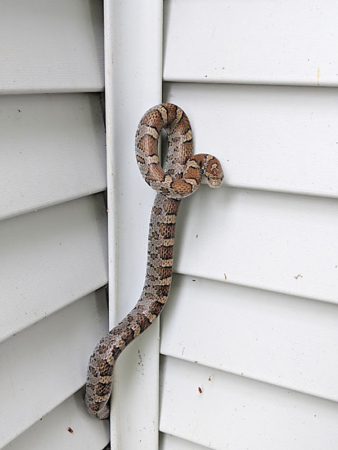I think summer is finally here and with the warmer temperatures we are also faced with frequent grass mowing and in my case plenty of weeds, but it is also the season for surprise visits by a number of different creeping, crawling and slithering critters. For example, last week I looked out front and noticed what looked like a large flat rock on the road in front of my driveway. I had just pulled in a few minutes before and it wasn’t there, so I went out to get the obstruction off the road. The “rock” turned out to be a large Wood Turtle. Wood Turtles for the most part are very terrestrial and although at home in water they often wander far afield, through wooded areas, fields and our backyards. A mature Wood Turtle shell may be 8-9 inches long and there is orange under the neck and on the legs. I moved the turtle to a safe place in the woods behind my house.
While the slow creeping turtle doesn’t create too much alarm in the backyard the slithering snake is seldom a welcome visitor. A couple of weeks ago my daughter-in-law sent me a photo of a fairly large snake that was spotted crawling underneath their deck and she wanted me to identify it for her. I informed her that it was a harmless Eastern Milk Snake also referred to as a “house snake” or “barn snake”. Because of the brown blotchy pattern, the snake is often misidentified and sometimes thought to be a venomous copperhead. The name Milk Snake comes from a ridiculous belief by some that because the snake was often found in and around barns that it was there to “milk the cows”. The snake does like to hang around barns, sheds and even houses because it is in search of mice and other such critters. My daughter-in-law wisely welcomed the snake in hopes it would help control mice in their pigpen.
Another frequent visitor to our backyards is the common Black Rat Snake. As the name implies these snakes are black but in some cases, there may be traces of a spotted pattern. While these snakes are harmless, they can be aggressive when being captured; they will bite and their small, sharp teeth will definitely draw blood. Usually after being handled for a bit they calm down, stop striking and simply try to crawl away. These snakes can grow to a pretty good size; I have captured some at least six feet in length. They are often found near houses and other buildings in search of rodents, but they are also excellent tree climbers and I have spotted them well up in trees seeking out birds’ nests for their next meal.
This past week I answered the call to remove a large Black Rat Snake from my neighbor lady’s backyard-it wasn’t invited to their picnic. If you are not familiar with and comfortable with handling snakes, you probably shouldn’t attempt to handle them. I’ve been catching and handling snakes since I was just a kid so it’s no problem for me. I don’t see a need to kill these snakes and they can often be shooed out of harm’s way with some simple prodding with a stick.
Finally, on the “slimy” side of things I recently waded into a clear stream to do a little fishing and minutes later I looked down by my feet and spotted a large Eastern Hellbender. Hellbenders are one of the largest salamanders in North America; this one appeared to be about 20 plus inches in length. It’s been several years since I have seen one. They live in clear, healthy streams and today I believe they are a protected species. Keep your eyes open-who knows what you might see even in your own backyard.





Leave a Comment
Your email address will not be published. Required fields are marked with *